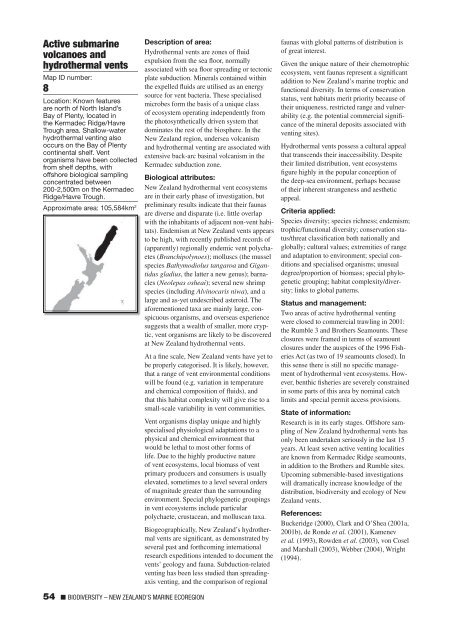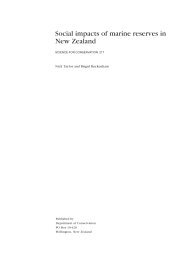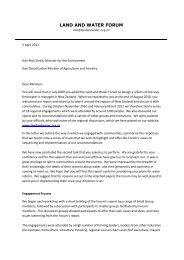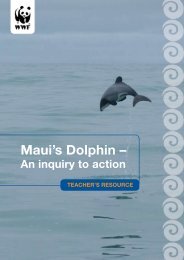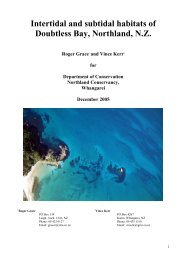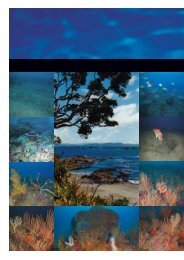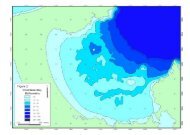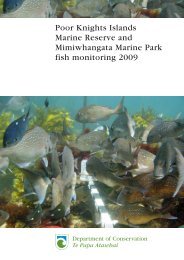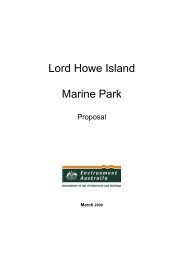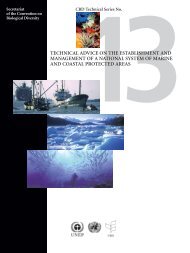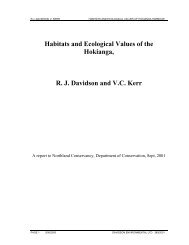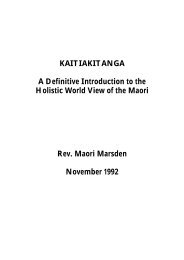WWF Shining a spotlight on the biodiversity of ... - MarineNZ.org.nz
WWF Shining a spotlight on the biodiversity of ... - MarineNZ.org.nz
WWF Shining a spotlight on the biodiversity of ... - MarineNZ.org.nz
Create successful ePaper yourself
Turn your PDF publications into a flip-book with our unique Google optimized e-Paper software.
Active submarine<br />
volcanoes and<br />
hydro<strong>the</strong>rmal vents<br />
Map ID number:<br />
8<br />
Locati<strong>on</strong>: Known features<br />
are north <strong>of</strong> North Island’s<br />
Bay <strong>of</strong> Plenty, located in<br />
<strong>the</strong> Kermadec Ridge/Havre<br />
Trough area. Shallow-water<br />
hydro<strong>the</strong>rmal venting also<br />
occurs <strong>on</strong> <strong>the</strong> Bay <strong>of</strong> Plenty<br />
c<strong>on</strong>tinental shelf. Vent<br />
<strong>org</strong>anisms have been collected<br />
from shelf depths, with<br />
<strong>of</strong>fshore biological sampling<br />
c<strong>on</strong>centrated between<br />
200-2,500m <strong>on</strong> <strong>the</strong> Kermadec<br />
Ridge/Havre Trough.<br />
Approximate area: 105,584km 2<br />
Descripti<strong>on</strong> <strong>of</strong> area:<br />
Hydro<strong>the</strong>rmal vents are z<strong>on</strong>es <strong>of</strong> fluid<br />
expulsi<strong>on</strong> from <strong>the</strong> sea floor, normally<br />
associated with sea floor spreading or tect<strong>on</strong>ic<br />
plate subducti<strong>on</strong>. Minerals c<strong>on</strong>tained within<br />
<strong>the</strong> expelled fluids are utilised as an energy<br />
source for vent bacteria. These specialised<br />
microbes form <strong>the</strong> basis <strong>of</strong> a unique class<br />
<strong>of</strong> ecosystem operating independently from<br />
<strong>the</strong> photosyn<strong>the</strong>tically driven system that<br />
dominates <strong>the</strong> rest <strong>of</strong> <strong>the</strong> biosphere. In <strong>the</strong><br />
New Zealand regi<strong>on</strong>, undersea volcanism<br />
and hydro<strong>the</strong>rmal venting are associated with<br />
extensive back-arc basinal volcanism in <strong>the</strong><br />
Kermadec subducti<strong>on</strong> z<strong>on</strong>e.<br />
Biological attributes:<br />
New Zealand hydro<strong>the</strong>rmal vent ecosystems<br />
are in <strong>the</strong>ir early phase <strong>of</strong> investigati<strong>on</strong>, but<br />
preliminary results indicate that <strong>the</strong>ir faunas<br />
are diverse and disparate (i.e. little overlap<br />
with <strong>the</strong> inhabitants <strong>of</strong> adjacent n<strong>on</strong>-vent habitats).<br />
Endemism at New Zealand vents appears<br />
to be high, with recently published records <strong>of</strong><br />
(apparently) regi<strong>on</strong>ally endemic vent polychaetes<br />
(Branchipolynoes); molluscs (<strong>the</strong> mussel<br />
species Bathymodiolus tangaroa and Gigantidus<br />
gladius, <strong>the</strong> latter a new genus); barnacles<br />
(Neolepas osheai); several new shrimp<br />
species (including Alvinocaris niwa), and a<br />
large and as-yet undescribed asteroid. The<br />
aforementi<strong>on</strong>ed taxa are mainly large, c<strong>on</strong>spicuous<br />
<strong>org</strong>anisms, and overseas experience<br />
suggests that a wealth <strong>of</strong> smaller, more cryptic,<br />
vent <strong>org</strong>anisms are likely to be discovered<br />
at New Zealand hydro<strong>the</strong>rmal vents.<br />
At a fine scale, New Zealand vents have yet to<br />
be properly categorised. It is likely, however,<br />
that a range <strong>of</strong> vent envir<strong>on</strong>mental c<strong>on</strong>diti<strong>on</strong>s<br />
will be found (e.g. variati<strong>on</strong> in temperature<br />
and chemical compositi<strong>on</strong> <strong>of</strong> fluids), and<br />
that this habitat complexity will give rise to a<br />
small-scale variability in vent communities.<br />
Vent <strong>org</strong>anisms display unique and highly<br />
specialised physiological adaptati<strong>on</strong>s to a<br />
physical and chemical envir<strong>on</strong>ment that<br />
would be lethal to most o<strong>the</strong>r forms <strong>of</strong><br />
life. Due to <strong>the</strong> highly productive nature<br />
<strong>of</strong> vent ecosystems, local biomass <strong>of</strong> vent<br />
primary producers and c<strong>on</strong>sumers is usually<br />
elevated, sometimes to a level several orders<br />
<strong>of</strong> magnitude greater than <strong>the</strong> surrounding<br />
envir<strong>on</strong>ment. Special phylogenetic groupings<br />
in vent ecosystems include particular<br />
polychaete, crustacean, and molluscan taxa.<br />
Biogeographically, New Zealand’s hydro<strong>the</strong>rmal<br />
vents are significant, as dem<strong>on</strong>strated by<br />
several past and forthcoming internati<strong>on</strong>al<br />
research expediti<strong>on</strong>s intended to document <strong>the</strong><br />
vents’ geology and fauna. Subducti<strong>on</strong>-related<br />
venting has been less studied than spreadingaxis<br />
venting, and <strong>the</strong> comparis<strong>on</strong> <strong>of</strong> regi<strong>on</strong>al<br />
faunas with global patterns <strong>of</strong> distributi<strong>on</strong> is<br />
<strong>of</strong> great interest.<br />
Given <strong>the</strong> unique nature <strong>of</strong> <strong>the</strong>ir chemotrophic<br />
ecosystem, vent faunas represent a significant<br />
additi<strong>on</strong> to New Zealand’s marine trophic and<br />
functi<strong>on</strong>al diversity. In terms <strong>of</strong> c<strong>on</strong>servati<strong>on</strong><br />
status, vent habitats merit priority because <strong>of</strong><br />
<strong>the</strong>ir uniqueness, restricted range and vulnerability<br />
(e.g. <strong>the</strong> potential commercial significance<br />
<strong>of</strong> <strong>the</strong> mineral deposits associated with<br />
venting sites).<br />
Hydro<strong>the</strong>rmal vents possess a cultural appeal<br />
that transcends <strong>the</strong>ir inaccessibility. Despite<br />
<strong>the</strong>ir limited distributi<strong>on</strong>, vent ecosystems<br />
figure highly in <strong>the</strong> popular c<strong>on</strong>cepti<strong>on</strong> <strong>of</strong><br />
<strong>the</strong> deep-sea envir<strong>on</strong>ment, perhaps because<br />
<strong>of</strong> <strong>the</strong>ir inherent strangeness and aes<strong>the</strong>tic<br />
appeal.<br />
Criteria applied:<br />
Species diversity; species richness; endemism;<br />
trophic/functi<strong>on</strong>al diversity; c<strong>on</strong>servati<strong>on</strong> status/threat<br />
classificati<strong>on</strong> both nati<strong>on</strong>ally and<br />
globally; cultural values; extremities <strong>of</strong> range<br />
and adaptati<strong>on</strong> to envir<strong>on</strong>ment; special c<strong>on</strong>diti<strong>on</strong>s<br />
and specialised <strong>org</strong>anisms; unusual<br />
degree/proporti<strong>on</strong> <strong>of</strong> biomass; special phylogenetic<br />
grouping; habitat complexity/diversity;<br />
links to global patterns.<br />
Status and management:<br />
Two areas <strong>of</strong> active hydro<strong>the</strong>rmal venting<br />
were closed to commercial trawling in 2001:<br />
<strong>the</strong> Rumble 3 and Bro<strong>the</strong>rs Seamounts. These<br />
closures were framed in terms <strong>of</strong> seamount<br />
closures under <strong>the</strong> auspices <strong>of</strong> <strong>the</strong> 1996 Fisheries<br />
Act (as two <strong>of</strong> 19 seamounts closed). In<br />
this sense <strong>the</strong>re is still no specific management<br />
<strong>of</strong> hydro<strong>the</strong>rmal vent ecosystems. However,<br />
benthic fisheries are severely c<strong>on</strong>strained<br />
in some parts <strong>of</strong> this area by nominal catch<br />
limits and special permit access provisi<strong>on</strong>s.<br />
State <strong>of</strong> informati<strong>on</strong>:<br />
Research is in its early stages. Offshore sampling<br />
<strong>of</strong> New Zealand hydro<strong>the</strong>rmal vents has<br />
<strong>on</strong>ly been undertaken seriously in <strong>the</strong> last 15<br />
years. At least seven active venting localities<br />
are known from Kermadec Ridge seamounts,<br />
in additi<strong>on</strong> to <strong>the</strong> Bro<strong>the</strong>rs and Rumble sites.<br />
Upcoming submersible-based investigati<strong>on</strong>s<br />
will dramatically increase knowledge <strong>of</strong> <strong>the</strong><br />
distributi<strong>on</strong>, <strong>biodiversity</strong> and ecology <strong>of</strong> New<br />
Zealand vents.<br />
References:<br />
Buckeridge (2000), Clark and O’Shea (2001a,<br />
2001b), de R<strong>on</strong>de et al. (2001), Kamenev<br />
et al. (1993), Rowden et al. (2003), v<strong>on</strong> Cosel<br />
and Marshall (2003), Webber (2004), Wright<br />
(1994).<br />
54 ■ BIODIVERSITY – NEW ZEALAND’S MARINE ECOREGION


